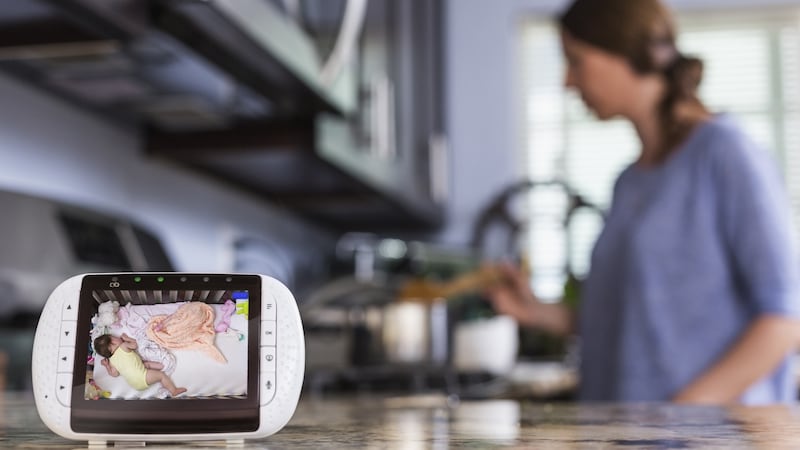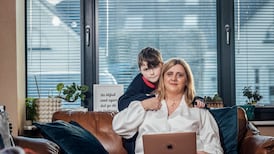“No parent can watch over their precious one at all times,” goes the advertising blurb for a monitor that clips on to your baby’s nappy and sets off an alarm if they stop moving.
These days, though, any parent prepared to splash out can conduct a surveillance operation that would make the CIA’s efforts look slapdash.
There are clip-on monitors you attach to your baby’s nappy or babygro to track every “micro-movement”, and alert you by text if they should stop moving for any reason, all the while gently massaging your baby’s tummy.
There are “womb music monitors” offering live audio streams of your baby’s kicks and hiccups (€50 plus shipping from Amazon).
There are baby breathing monitors (€91 plus shipping from Amazon) and "smart socks" to track your baby's heart rate and oxygen levels while they sleep ($300 from Owlet, only available in the United States and Canada). Parents can set their phone to synch with the smart sock so that it sends them regular "real-time wellness data" updates.
There are monitors you can attach to your baby’s neck to track how many times they swallow while breastfeeding, providing “mothers with real-time knowledge of their baby’s milk intake and nursing habits. Our proven technology detects and analyses your baby swallows by applying sophisticated signal and pattern recognition techniques,” promises the Momsense breastfeeding meter (€57 from Amazon).
It allows you to listen live via earphones to your baby’s swallows and record the audio from each breastfeeding session, presumably so you can play it back for delighted friends and family later.
When it comes to baby sleep monitors, gone are the longer crackly devices with the sophistication and range of Buzz Lightyear’s walkie-talkie. Even low-spec devices today come wifi-enabled and offer video surveillance, and many have additional features like night vision temperature monitoring, or alerts to let you know if a blanket has slipped off. The very latest generation monitors don’t just sit passively on a shelf near your baby’s bed: they are designed to be worn by the baby so that they can send you real-time notifications and health data.
Movement data
There’s the MonBaby Smart Button (€112 from Amazon), which clips on to your infant’s babygro, and sends live breathing and movement data to your phone. An alarm is activated if the unthinkable occurs, and your baby rolls on to their stomach or falls over. It also doubles as a sleep tracker.
So does the Mimo smart monitor ($123.90, currently only available in the US), which records what it calls “motion events” and claims to help parents “see patterns they never thought existed and develop plans to improve sleep routines”. The Mimo synchs up to a parent’s Nest home-monitoring system, so you can remotely adjust the temperature of the nursery and get notifications of any unusual activity to your phone. “Asleep on their side. Unusually low temperature,” one such alert might read.
Some high-tech parents bypass baby monitors altogether, preferring to co-opt their Nest cameras to train it on their sleeping child. And for those who favour the more surreptitious surveillance route, there are cameras disguised as tiny robot toys, so the nanny never needs to know you’re monitoring her. For a few euro extra, you can upgrade your baby monitor with a wide angle or even a 360 degree lens.

The 24-hour monitoring capability doesn’t have to stop when the baby leaves the house. Many creches now offer live video streams, allowing parents to check in remotely on their infants during the working day. When the little ones graduate to school-going age, there are GPS tracking devices disguised as pendants, watches, keyrings or hairbands.
But just because you can now monitor your baby’s every “micro-movement” and “motion event” every moment of every day doesn’t mean you should. Are these devices really ensuring the safety of the next generation, or are they preying on the vulnerabilities of anxious, overachieving parents? And could they even be feeding into the anxieties they claim to assuage?
John Sharry, The Irish Times parenting expert, takes the view that technology is a neutral force: what matters is how we use it.
“Technology can help people to feel more connected and see their children during the day, especially with things like live video streams from creches. Assuming it’s transparent and not covert, and all the staff are aware of it, I don’t see a problem with it. If the parent is anxious anyway, and if it helps them feel connected and reassures them that their children are being well looked after, then it’s a good thing. It’s when the monitoring becomes obsessive, it might be problematic.”
This potential downside is apparent on the customer reviews for the award-winning Owlet smart socks on Amazon. One parent writes: "With the Owlet I can check my phone and see that my LO [little one]'s stats are normal without having to get up at night and actually lean over the crib and try and see if he's breathing."
Sympathise
But, she adds, “Half the time I can’t even tell without turning on a light anyway and by that point I’m so awake that I can’t get back to sleep even though the baby’s totally fine and sleeping soundly.”
That parent gave it five stars – even if it doesn’t sound like it has been a totally life-enhancing addition to the household.
I can sympathise.
When my second child was born early and quite a bit underweight, my instinct to catastrophise went into overdrive. I bought so many disinfectant wipes, gels and sprays I should have had shares in Milton, and I also invested in a first-generation movement monitor that slotted in underneath his mattress and set off an alarm if he stopped moving.
While he thrived, I became more anxious, more deeply embedded in my state of hyper-vigilance. I hardly slept at all, waking at regular intervals to the dull buzzing of the monitor. Several heart-stopping false alarms, after he learned to roll off the mat and press himself against the edge of the cot, I could take it no more: I turned the thing off. And somehow, he survived.
When my third child came along three years ago, we invested in one of the video monitors that had, by then, become a routine part of every new parent’s survival kit. After we moved her into her own room, I spent weeks lying awake at night and staring at the monitor, watching her every movement, and willing her not to wake. By a happy twist of fate, it stopped working when she was a few months old and we never replaced it, opting for the time-worn method of leaving both doors open instead. Almost immediately, I started sleeping better, and – miraculously – so did she. Or maybe I just didn’t hear her anymore. But once again, somehow, she survived.
Lisa Kelly, a parent of two children, aged 6 and 4, had a similar experience, using a movement sensor which, she says “caused me no end of sleepless nights”.
“The movement sensor seems like a good idea, but we found it went off if the baby moved off the pad or held her breath, which caused us to jump out of bed in fright on several occasions when the alarm went off. We turned the pad off in the end.”
Kelly says she would be concerned about the security risks of wifi-enabled monitors “and the ability of third parties to access the image of the child and broadcast it over the internet”.
Control our fate
Psychotherapist and author of Bully-Proof Kids, Stella O'Malley, is more concerned about the psychological toll on parents. "It encourages the idea that if we relax for even a moment that our lives will come crashing down and tragedy will strike," she says.
“Mass marketing is encouraging the lie that we can control our fate, that we can avoid accidents and remove the possibility of risk if we throw enough money at it. But we can’t. And vast amounts of gadgets won’t stop accidents happening – they generally add to our tension and stress.”
A parent herself, O’Malley says she used a standard, audio-only, non-video baby monitor for two weeks when her first child was born. “Within about two weeks, I turned it off and never used it again. I could hear my baby crying from a million miles away; those cries seared my heart and I would jump up and charge straight to her cot – I certainly didn’t need an amplified version of her cries right beside my bed to add to my heightened emotions.”
Joe Langan, who lives in Ashbourne, Co Meath, with his wife, Catherine McGillycuddy, and their seven-month-old daughter, Alice, disagrees. He says he is “a rational worrier. I think I very much associate risk with statistics. Having a baby monitor is very much tied up in assuaging that fear.”
He is a fan of the family’s Angelcare baby monitor, which includes a mattress sensor. “It definitely reassured us. We moved Alice into her own room after four months because, if anything, our sleeping was disturbing her. She’s done really well on her own and as the weeks of no problems rack up, the panicky feelings diminished.”
They removed the sensor pad after three months, but recently started using it again at seven months, because Alice often ends up asleep on her stomach. “We associate that – rightly or wrongly – with increased risk. And like the last time we used the sensor pad, the biggest risk ends up being our own foggy brains leading us to pick Alice up in the middle of the night to feed her, forgetting to switch off the pad, disturbing whatever calm we’d established up to that point.”
But he stopped short at enabling the feature on the monitor that makes it beep every three seconds to confirm that all is well.
“That’s a level of paranoia a lot of new parents could relate to, but I think it also has the potential to be a real hindrance. Striking a balance between what you can control with technology and what you should control is vital for your own sanity.”











